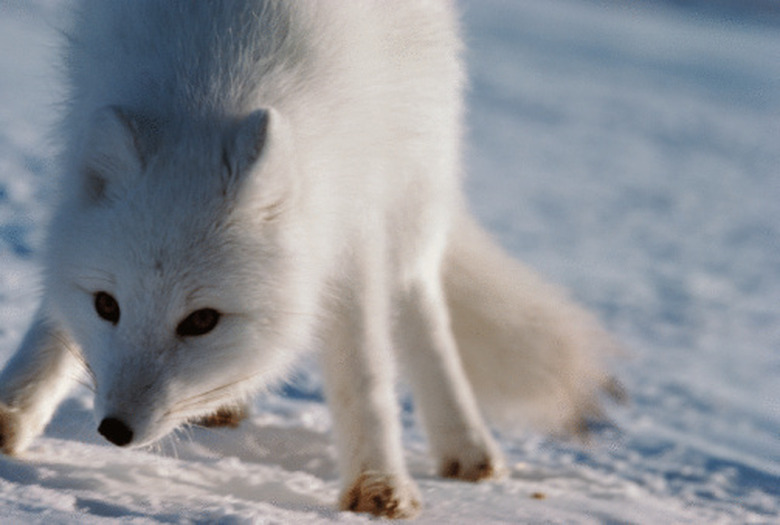Omnivores Of The Tundra
The tundra circumnavigates the North Pole and includes northern parts of Canada and the state of Alaska. It is a cold and barren wasteland that supports very little vegetation, as the ground is permanently frozen under the soil layer. Shrubs, lichens, sedges, mosses and grasses can be found though, as can a variety of flowers, although the growing season is only two months long. Tundra omnivores are principally flesh eating animals, which consume plant matter when meat becomes scarce.
Arctic Fox
Arctic Fox
The Arctic fox is a solitary hunter, which is active during the daylight hours. Arctic foxes feed mainly on small mammals and fish, but will scavenge as necessary. They will follow both wolves and polar bears, in the hope of feeding on the remains of their kill and eat the feces of other tundra animals when food is particularly scarce. During times of plenty, voles and lemmings make up a major part of this fox's diet, and the population of the Arctic fox is governed to some extent by the rise and fall in lemming numbers. Arctic foxes will feed on berries when meat is not available and will eat birds, their eggs and insects, as necessary.
Polar Bears
Polar Bears
These huge bears prey mainly on bearded and ringed seals, but feed on other seal species as well. Polar bears will scavenge on the walrus and narwhal carcasses, as well as on the remains of bowhead and beluga whales. If the opportunity presents itself, these hunters will kill both juvenile walruses and beluga whales. Polar bears are opportunistic feeders and will also hunt reindeer and feed on various bird species, fish and rodents. These bears will eat berries and kelp that has been washed up onto shore, but choose a diet of ice seals, when food is plentiful. The stomach of a polar bear can hold the equivalent of 15 to 20 percent of its body weight.
Tundra Wolf
Tundra Wolf
Tundra wolves are highly social and hunt in groups, termed packs. During times of plenty, these wolves feed on musk ox and caribou, but they will feed on arctic hare and lemmings as well. When food is scarce, tundra wolves will eat berries and fruit. Like all of the tundra predators, these wolves are opportunistic feeders and will eat whatever they come across during the periods when food is particularly difficult to find.
Grizzly Bear
Grizzly Bear
Grizzlies are found on the Alaskan and northwestern Canadian tundra. These bears feed on the carcasses of caribou and other winter-killed species, but are easily capable of hunting and overpowering muskoxen, wild sheep and moose when the opportunity arises. Grizzly bears will also eat ground squirrels and lemmings and will feed on a variety of berries and plants. Legume roots, horsetails, sedges and various grasses are also eaten.
Cite This Article
MLA
Bolton, Naomi. "Omnivores Of The Tundra" sciencing.com, https://www.sciencing.com/omnivores-tundra-8339816/. 22 November 2019.
APA
Bolton, Naomi. (2019, November 22). Omnivores Of The Tundra. sciencing.com. Retrieved from https://www.sciencing.com/omnivores-tundra-8339816/
Chicago
Bolton, Naomi. Omnivores Of The Tundra last modified March 24, 2022. https://www.sciencing.com/omnivores-tundra-8339816/
